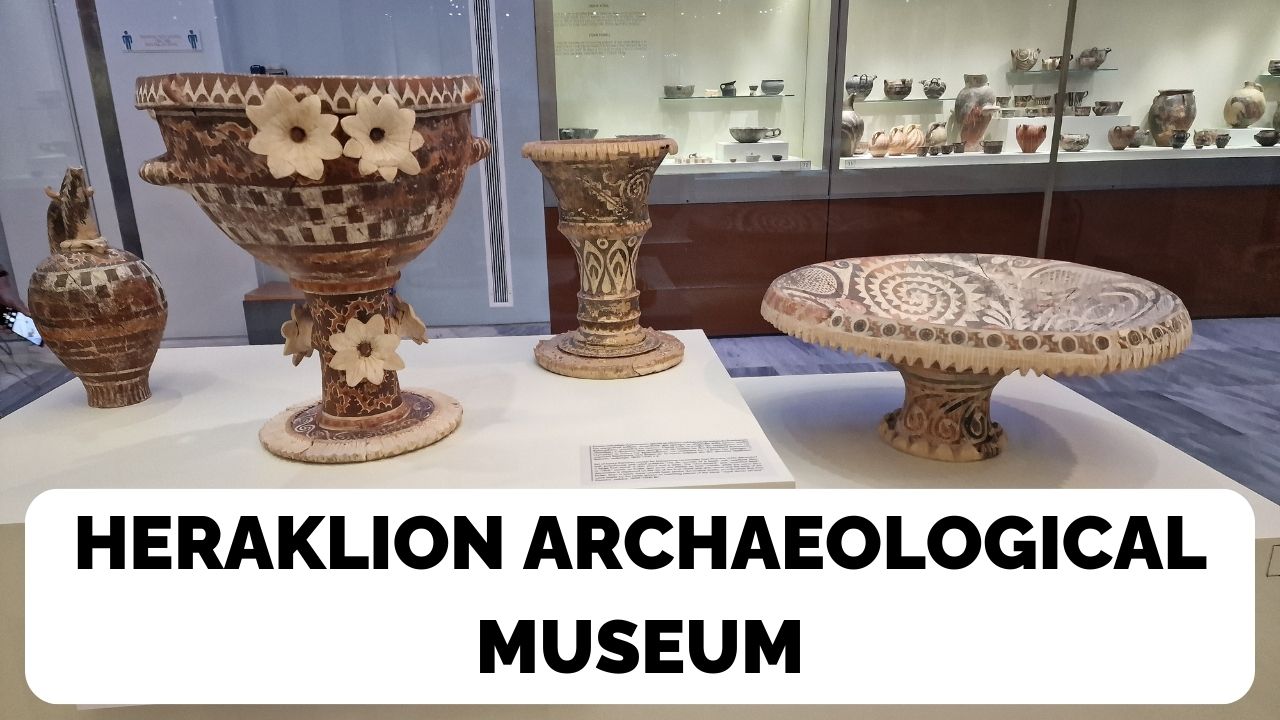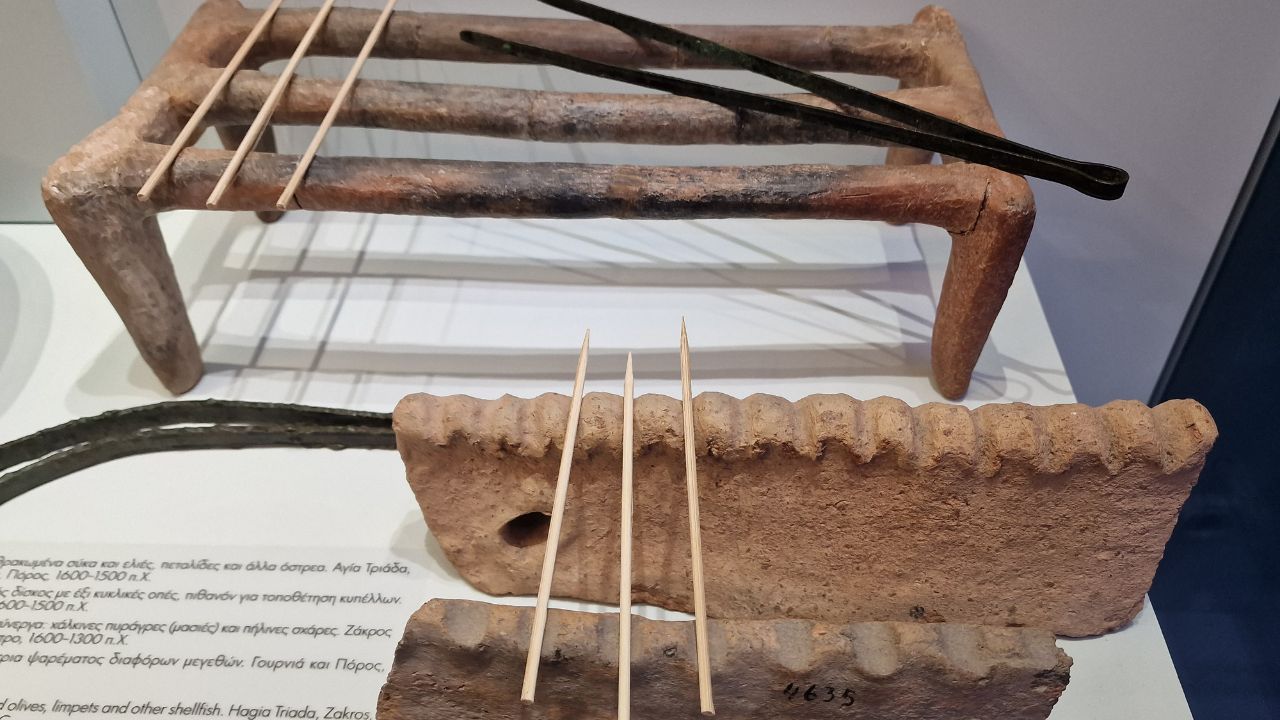The Archaeological museum of Heraklion is one of the most important museums in Greece, housing unique findings from the Minoan civilization.

Archaeological Museum Of Heraklion
When visiting Heraklion, the capital of Crete, one cannot miss out on a visit to its famous Archaeological Museum.
Work on a museum building first began in 1904 and it has since become one of the most important archaeological museums in Greece.
Inside the museum is housed a vast collection of artefacts from the Minoan civilization, one of the earliest and most advanced civilizations in Europe.

Most people choose to visit the Heraklion Archaeological Museum after visiting Knossos Palace, but it doesn't really matter which order you choose as long as you don't miss out on visiting both.
I've visited the Heraklion Archaeological Museum about half a dozen times now on my various trips to Crete, and never fail to be amazed by the incredible Minoan Art, pottery, and ceramic works found there.
Highlights of the Museum
The museum's collection is spread over 20 rooms, showcasing objects dating from the Neolithic to Roman times.
In my opinion, you should allow 3 to 4 hours to really get to see it, but you can just as easily walk through at a quicker pace and spend just an hour there if you are tight on time.
Some notable highlights include:
- The Phaistos Disc: This clay disc, discovered at the Palace of Phaistos, still remains undeciphered and is one of the most intriguing objects in the museum.
- The Snake Goddess: This famous Minoan figurine depicting a goddess holding snakes is a symbol of power and fertility.
- Bull-leaping Fresco: Another well-known piece from Knossos Palace, this fresco depicts young men and women performing acrobatic feats over a bull.
- Sarcophagi: The museum houses the largest collection of Minoan sarcophagi, including the famous ‘Kriti' sarcophagus with intricate carvings and scenes from Minoan mythology.
- Double Axes: These ceremonial axes, commonly found in Minoan palaces, are a symbol of power and authority.

Apart from these notable highlights, the museum also features a variety of other fascinating objects such as pottery vases with intricate designs, jewellery, and everyday items used by the Minoans.
Getting to The Heraklion Archaeological Museum
The museum is located in the centre of Heraklion, just a short walk from the main promenade and Old Port area. It's a 6 minute walk from Morossini Fountain, which can be considered the very centre of Old Town Heraklion.
If you're staying in Heraklion, it's within walking distance from most hotels and easily accessible by public transportation.
Parking nearby is another issue entirely! I strongly suggest against trying to park near the center of Heraklion if you have rented a car, as finding space is a nightmare.
If you've decided to get a Hop On Hop Off bus ticket (a pretty good idea if you don't have much time to spare and want to see a lot), it stops outside.
Ticket Lines And Options
During the summer months, there can be long lines to get tickets. To save time, it's best to buy tickets online at the official website or opt for a combination ticket that includes entry to Knossos Palace and the Archaeological Museum.

Note that i am not 100% certain the combo ticket can be bought online, but it will work out cheaper if you intend to visit both the Herakleion Archaeological Museum and Knossos.
General admission costs €12 per person, but there are discounts available for students, and senior citizens. In the off season, admission prices are halved.
In addition, between November and March the first Sunday of every month will have free entry.
What To Expect In The Archaeological Museum of Heraklion
The museum is renowned for housing the world's most significant collection of Minoan antiquities, making it a specialized institution dedicated to Minoan Culture.
Within the museum's extensive collection, visitors can explore artifacts dating from the Neolithic period to the Roman era, spanning from Cretan prehistory of the 6th millennium BC to the 3rd century AD.

These artifacts predominantly belong to the Minoan Period and encompass a diverse array of art forms, including ceramic art, stone carving, seal engraving, micro-sculptures, metal craftsmanship, and paintings discovered in palaces, buildings, settlements, tombs, temples, and caves.
The museum holds a total of 20 rooms, each featuring different exhibitions and themes. The collections are carefully curated and presented in chronological order, making it easier for visitors to understand the evolution of Minoan culture.
You'll also find some Minoan wall paintings in the museum taken from Knossos.
My favourite things to see in the AMH
I've always found the Minoan civilisation to be one of those mysterious cultures that leaves me with lots of questions and few answers.
With an absence of decipherable written records, the Minoans remain a bit of an enigma. But this is also what makes them so fascinating.

That's probably why the Phaistos Disc happens to be one of my favourite exhibits in the museum. It's a great talking point and sparks many debates and thoughts about its meaning and usage.
Other favourites include the snake Goddess figurines, bronze double axes which may have been a symbol of the Minoans, the Bull's head statues (another symbol), and some of the bronze weaponry.

Heraklion archaeological museum photos
Here's a few photos from my last visit to the museum:

The above photo could be one of the first souvlaki cooking devices ever found!

I'm not sure what to make of the pottery shown above!
Heraklion Archaeological Museum Opening Hours
The Heraklion museum opening hours vary depending on the day and the time of year you want to visit.
For the latest opening hours, check out the museum website.
FAQ
How long does it take to visit Heraklion Archaeological Museum?
Depending on your pace and level of interest, the museum can take anywhere from 1-3 hours to fully explore.
Is it worth visiting the Heraklion Archaeological Museum?
Absolutely! The museum holds a vast collection of ancient artifacts that offer insight into Minoan culture and history. It's a must-visit for anyone interested in archaeology or ancient civilizations.
Why is Heraklion famous?
Heraklion is famous for being the capital and largest city of Crete, as well as its rich history and archaeological sites such as Knossos Palace and the Heraklion Archaeological Museum. It also serves as a popular tourist destination due to its beautiful beaches, vibrant nightlife, and delicious Cretan cuisine.
Where is the Minoan Palace of Knossos?
The Minoan Palace of Knossos is located about 5km south-east of Heraklion, in the valley of the Kairatos river. It can easily be reached by car or public transportation from the city center.
You might also want to read:
- Natural History Museum of Crete in Heraklion
- Do You Need to Rent a Car in Rethymnon?
- Heraklion Ferry Port To Heraklion Airport Transport
- Where to travel in Greece
- Is Chania or Heraklion Better For First Time in Crete?
 – Dave Briggs
– Dave BriggsDave is a travel writer from the UK who's been living in and writing about Greece since 2015. As well as writing this travel guide to the Archaeological Museum of Heraklion, he's also written hundreds more travel blog posts about Crete and other destinations in Greece. Follow Dave on social media for more Greece travel ideas: